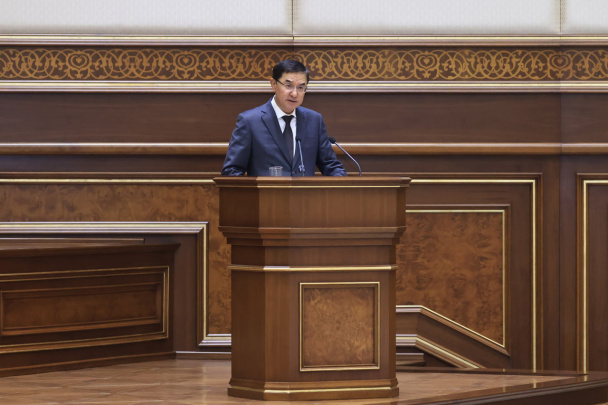Extreme heat returning to Uzbekistan
On July 17-22, the temperature in the territory of Uzbekistan is expected to rise to 47 degrees, breaking heat records. So how ready is the energy supply system? Will the problems seen in last year’s heat be repeated this year?

Photo: Kun.uz
The head of Uzhydromet Sherzodkhodja Khabibullakhodja issued urgent information and warned that on July 17-22, hot air will enter the territory of the republic from the territories of Iran through Turkmenistan, as a result of which the temperature will rise to 47 degrees.
Reportedly, as a result of the influx of warm air masses, the air temperature rises during the day as follows:
• Up to 44-47 degrees in Karakalpakstan, Khorezm, Bukhara, Navoi, Kashkadarya, Surkhandarya regions;
• Up to 42-45 degrees in Tashkent, Samarkand, Jizzakh, Syrdarya regions;
• Up to 41-43 degrees in Fergana Valley regions.
According to statistics, if the temperature in Tashkent rises to 45 degrees, it will be an absolute record of the period after 1870.
At the end of June, the population of Uzbekistan experienced the first wave of intense heat. According to Uzhydromet, on June 27-28, the heat reached its maximum level in the north and desert regions, on June 29 – in most of the regions. In some districts of the Republic of Karakalpakstan, Khorezm, Bukhara, Navoi, Kashkadarya and Samarkand regions, new records for maximum air temperature were set for June.
Abnormally warm days in themselves increase the need for air conditioning and refrigeration equipment, and the widespread use of such electrical equipment will cause an increase in the load on the power grid. So is the system ready for this kind of pressure?

Interruptions
In the following days, interruptions in energy supply began to be observed in a number of areas of Tashkent city. It’s true that the outages haven’t been lasting long yet, but cases like this hint that the grid can’t handle the strain before the anomalous heat returns.
Power outages were also observed in June. This is also confirmed by the appeals received from residents via Telegram to the Central Dispatch Service.

The analysis of appeals and responses to them in the Telegram-group shows that on the days of abnormally hot weather, malfunctions in the operation of many substations and transformers were observed, most likely these problems occurred due to the increased load in the system, as a result of interruptions in the supply of electricity, residents in some areas were left without water.
The company of the city’s electric networks explained this with abnormal heat and planned shutdowns in preparation for winter, and called on the population to “use energy sparingly”.

A new trick?
Officials are now providing low-voltage electricity as a solution to the problem. As a result of the increased load on the system, energy suppliers are transmitting electricity at a lower voltage, for example, 160-180 V, rather than at a voltage of 220 V according to the contract. Naturally, lamps in your house will work, TV and other energy-saving home appliances will work. However, devices such as refrigerators and air conditioners do not even light up at such a voltage.
This situation did not start yesterday or today. Complaints of this content are being observed last year, last month, and this day and night. So far, the population has not fully understood this trick of the energy suppliers.

On the same day when Uzhydromet announced its forecasts about the heat, Kun.uz appealed to the Ministry of Energy, asking for an explanation on how ready the country’s energy supply is for the increase in load. However, it was said that the ministry would not comment on this matter.
Last year, Kun.uz raised the issue of energy turning off during abnormally hot days, and people not being supplied with electricity in the heat. At that time, the officials of the industry said that transformers working in large substations, are heating up due to the sudden warming of the air, and they have to be turned off for 2-3 hours to cool down due to the fact that the oil that cools the coil inside them is boiling, and the interruptions occur only during the day when the sun is very hot, and there is no problem during the night hours.

President Shavkat Mirziyoyev instructed to prepare a draft decision on increasing electricity capacity after the blackout observed at the beginning of the year. According to the plan, by 2026, the total generation capacity should reach 27,400 megawatts, and the annual production volume should reach 110 billion kilowatt hours.
It’s no secret that the air temperature is high in Uzbekistan every year in May-September, especially in June-August. In such a situation, it is self-evident that the load on the system increases, the reasons for this have been discussed above. Knowing this, is it possible to ensure that the transformers do not overheat, to increase their number, to demand more money from the budget for transformers, to do the necessary work on energy import, to organize the work of call centers?

The Ministry of Energy is not completely silent, but has given its recommendation to avoid power outages: residents are asked to use electricity sparingly in the coming heatwave. Probably, those in the ministry also know that not much can be achieved with such calls. Why shouldn’t people calmly use the air conditioner when it’s abnormally hot outside?
In fact, electricity generation has increased significantly in recent years, and transformer renewal rates have doubled, but this should not prevent the authorities from respecting consumer rights, holding a press conference, and answering specific questions honestly.
Related News

16:27 / 21.12.2024
Tashkent's EV charging stations face dismantling and disconnection orders

11:16 / 19.12.2024
"Heating supply prices in Tashkent will increase 4 times in 2 years, but this is not enough" - Kuchkarov

10:51 / 19.12.2024
Uzbekistan to continue supplying electricity to Afghanistan through 2025

16:59 / 18.12.2024



